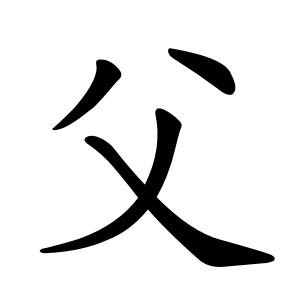父
- father;
- elder member of the family;
Etymology
This character consists of a single vertical stroke and 又 (the "right hand" radical). In oracle bone script and bronze inscriptions, it depicts a hand holding an object like a stick.
The Shuowen Jiezi (説文解字 shuōwén jiězì) interprets it as "a hand holding a stick." Modern scholars generally interpret the object as a stone axe, understanding the character originally meant "axe." Over time, the meaning evolved from "a man holding an axe at work" to signify "father." The original meaning of "axe" was later taken over by the character 斧 (axe radical).
Usage in Korean
When used as a radical, it generally conveys meanings related to an elderly man (likely a father). However, the number of characters classified under this radical is quite small. Examples include 爺 (grandfather) and 爸 (dad).
Other characters containing this radical usually have additional radicals as well, so 父 is often not treated as the primary radical in those cases.
- 金大 (CK)
- ⿱ 八 乂 (G H J T V)
- ⿱ 八 ⿻ 乀 丿 (K)
